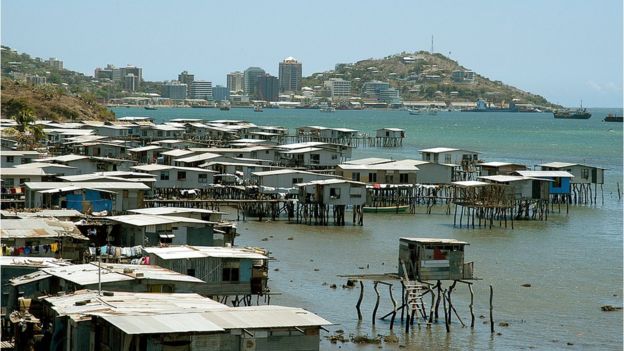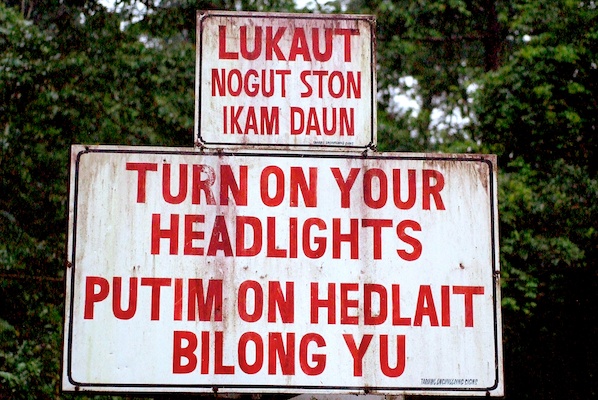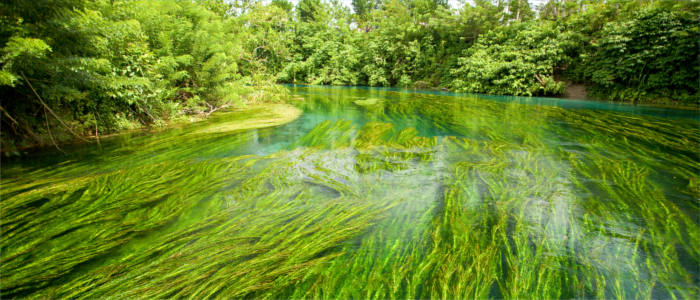Papua
New Guinea, at least for the things I end up reading, always seems to wind up
on the strangest of lists. There have been several times when I’ve come across
this country on lists of weird, bad, or dangerous things. Or really remote
one-of-a-kind kind of lists, which aren’t quite as bad. I’m really hoping
there’s more to this country than the scary human rights issues I’ve read about
and poisonous animals. So, my mission is to find out what things are really
like here and what kind of secrets I don’t know about yet.
The
name of the country as we know it didn’t come about until the 19th
century. The first part, Papua, is
derived from the Malay term that refers to the frizzy hair of the people,
especially anyone who’s from the Melanesian Islands. The second part, New Guinea, was named by the Spanish
since they thought the people reminded them of the Africans they met in and
around the country of Guinea.
The
country occupies the eastern half of the island of New Guinea, which is located
just north of Australia and is part of the broader Melanesian Islands. The
western half consists of the Indonesian provinces of West Papua and Papua. Its
easternmost island, Bougainville Island, is essentially on the northwestern end
of the Solomon Islands. The Solomon Sea separates the main island of New Guinea
from the Solomon Islands to the east while the Bismarck Sea lies to the north
in the midst of the Bismarck Archipelago. If you go even farther north, you’ll
run into Palau, Guam, and the Federated States of Micronesia. Because the
country is on the Pacific Ring of Fire, it has several active volcanoes and
experiences frequent earthquakes (sometimes leading to tsunamis). There are
several rivers, highland areas, and rainforest areas while coral reefs surround
the islands. Deforestation remains to be a problem for the country. Papua New
Guinea lies just below the equator and is one of the few equatorial countries to
also have snow (in the higher elevations).
The
first people arrived in Papua New Guinea as a result of one of the first human
migrations in the world. Africans arrived in the islands somewhere around
45,000 years ago, and they developed agriculture in the highlands. Another wave
of migration took place around 500 BC from various other tribes around the
Southeast Pacific Islands. Portuguese and Spanish traders arrived during the
16-18th centuries and introduced several vegetables, including the
sweet potato, which significantly enhanced their agriculture. Many of them were
after the plumes of the bird of paradise. The southern half of the island was
handled by the UK and called British New Guinea. In 1905, the British handed
that control over to Australia who renamed it Territory of Papua, but
technically, on the books, it was still a possession of the UK. During the end
of the 1800s, Germany controlled the northern side of the island, calling it
German New Guinea; however, Australia captured and controlled it during WWI. During
WWII, the Japanese, Australians, and the US fought a major battle where almost
a quarter-million people died. After WWII, the two sides were united and
referred to as Papua New Guinea. They gained their independence from Australia
in 1975, although they do remain part of the British Commonwealth. In 1988,
miners in Bougainville created an uprising concerning the fact that they were
bearing the brunt of the down side to mining (illnesses, environmental issues),
yet they weren’t compensated with a fair share of the profits in this. Even
today, there has been some discussion as to Bougainville’s autonomy.
Port
Moresby is located along the southern coast on the Papuan Peninsula. The city
is named after British Naval Officer John Moresby, the first European to site
the area where the future capital city would be. With only around 400,000
people, it’s also the country’s largest city. There are a couple of
international schools, several sports stadiums, museums, libraries, shopping
and markets, as well as its usual business district and high-rise apartments.
While many of these features used to be in the downtown district, quite a few
of them moved to suburbs and other neighborhoods during the 1990s.
The
islands are rife with natural resources, both on the land and in the sea.
However, there is also a lot of rough terrain, which makes it very difficult to
access. Minerals (like gold, copper, and oil) make up nearly three-quarters of
its export revenue. Palm oil is one of their major agricultural exports, even
though the palm oil industry has increasingly become quite controversial over
the past few years. (Watch this VICE video from Season 3 about the palm oil
industry in Indonesia. I would suggest watching the entire episode, but you can
skip ahead to the 16:00 mark for the story on palm oil.) Although PNG’s economy
has struggled in the past, it has also made some growth over the past decade.
They not only rely on mining, but they also have a growing oil and gas industry
as well.
Christianity
is overwhelmingly the majority religion in Papua New Guinea. Nearly 95% of the
population adheres to some form of Christianity, with the majority of those
following Protestantism. As far as the significantly smaller non-Christian population
goes, the Baha’i religion has the largest following, followed by Islam and
Confucianism. Animism and mysticism is still very much alive, especially in the
rural areas. Several high-profile cases have made news in the past few years of
women being tortured and burned alive on charges of witchcraft.
What’s
unbelievable is that this relatively small country has more than 820 languages,
but most of these languages have fewer than 1000 speakers, and several have
already died out. The most widely spoken indigenous language is Enga, followed
by two other Trans-New Guinea languages, Melpa and Huli. However, it is the #1
country in the world with the most languages. (Indonesia is second with 742,
and Nigeria is third with 516.) There are actually four official languages in
the country: Hiri Motu (a simplified form of the Motu language), Tok Pisin (an
English-based creole; once used as a trade pidgin, it is entirely its own
language now and serves as a first language for many), English (language of
government and education but not spoken by many people in everyday activities),
and Papua New Guinea sign language.
Papua
New Guinea is one of the world’s most remote areas. Not necessarily its
physical location, but its accessibility to traverse the country. Because of
its rough terrain, thick jungles, and swamps, there are areas few people have
ever visited (save, perhaps, for some of the locals). In fact, it’s nearly
impossible to build roads through some of these areas, and it’s easier to fly
to where you need to be. I wonder what secrets lay in the jungles. Could the
next cure for cancer lie within its green realm, or is its tight-knit foliage
saving itself from exploitation?
Up
next: art and literature








No comments:
Post a Comment